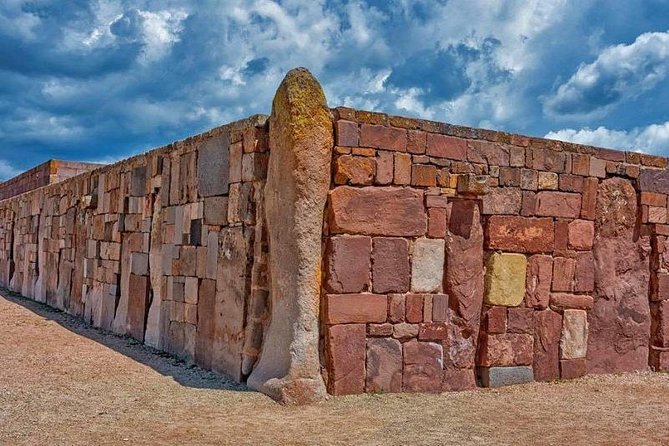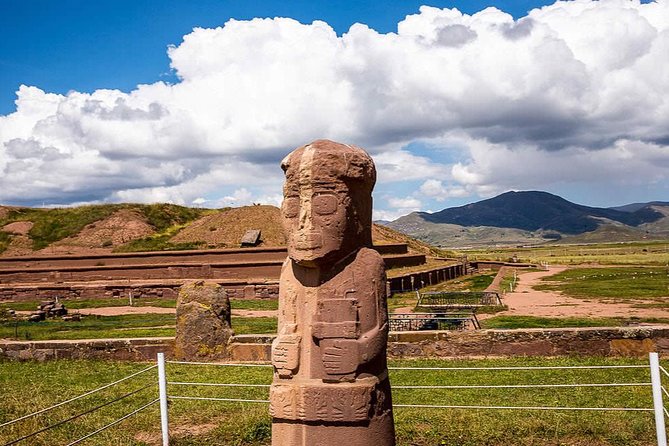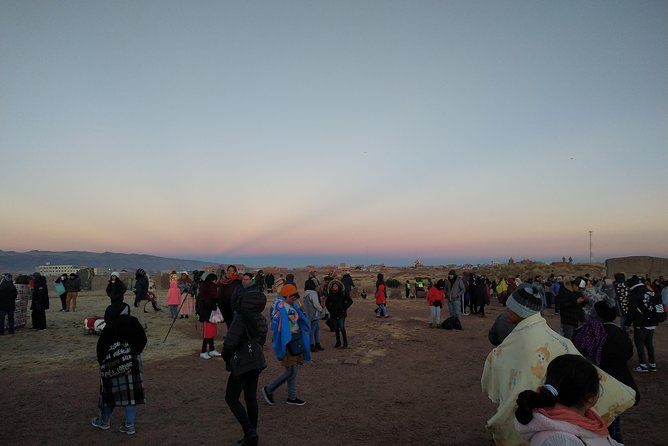The Tiwanaku Ruins stand as a testament to the advanced engineering and cultural sophistication of the ancient Tiwanaku civilization. Recognized as a UNESCO World Heritage site, these monumental structures were vital to the Tiwanaku’s spiritual and political practices. From the intricate stonework of the Pyramid of Akapana to the artistic carvings at the Kalasasayas Temple, the ruins offer a glimpse into the rich heritage of the Andean people. Visitors can explore this captivating pre-Colombian site and uncover the profound significance it held for the Tiwanaku culture.
Key Points
- The Tiwanaku site was a pre-Colombian spiritual and political center of the Tiwanaku culture, recognized as a UNESCO World Heritage site.
- Colossal structures and intricate stonework at Tiwanaku demonstrate the advanced engineering and architectural prowess of the Tiwanaku people.
- Key structures like the Pyramid of Akapana, Kalasasayas Temple, and Pumapumkus Pyramid showcase the cultural and spiritual significance of the site.
- The Litico Museum at Tiwanaku provides a comprehensive collection of artifacts and historical context about the Tiwanaku civilization.
- Guided tours of the Tiwanaku ruins offer insights into the site’s rich history and cultural significance, immersing visitors in the ancient traditions and beliefs of the Tiwanaku people.
Exploring Tiwanaku’s Significance

Tiwanaku’s significance as a pre-Colombian spiritual and political center can’t be overstated. This UNESCO World Heritage site served as the heart of the Tiwanaku culture, which dominated the region for centuries.
The colossal structures, intricate stonework, and advanced engineering feats found here bear witness to the impressive achievements of this ancient civilization. Visitors can explore the Pyramid of Akapana, Kalasasayas Temple, and Pumapumkus Pyramid, each offering a glimpse into the complex religious and sociopolitical systems that once thrived.
The Litico Museum further enriches the experience, showcasing an array of artifacts and providing valuable historical context.
Tiwanaku stands as a testament to the ingenuity and cultural sophistication of its inhabitants, making it a must-visit destination for those seeking to unravel the mysteries of South America’s past.
You can also read our reviews of more tours and experiences in La Paz.
Guided Tour Highlights

Exploring the remarkable ruins of Tiwanaku on a guided tour offers visitors a captivating window into the site’s rich history and cultural significance.
The morning tour takes guests through the iconic structures, including the Pyramid of Akapana, Kalasasayas Temple, and Pumapumkus Pyramid. Along the way, the knowledgeable guide provides insightful commentary, bringing the ancient city to life.
The Litico Museum, with its fascinating collection of artifacts, further enhances the experience. With a maximum group size of 10, the tour ensures an intimate and personalized exploration of this UNESCO World Heritage site.
The half-day format allows ample time for visitors to enjoy Tiwanaku’s captivating legacy.
Transportation and Logistics

For the convenience of visitors, convenient pickup options are available for the Tiwanaku ruins tour. Guests can be picked up from their hotels in central La Paz or meet the group at the designated meeting point, the iconic Basilica of Saint Francis.
The tour departs promptly at 8:00 am, allowing ample time to explore the expansive Tiwanaku archaeological site. Entrance fees to the ruins and museum are included in the tour price of 100 Bs.
While lunch isn’t provided, visitors can enjoy a variety of local dining options during the free afternoon hours. With a maximum group size of 10, this tour offers an intimate and educational experience exploring the spiritual and political heart of the Tiwanaku culture.
Group Size and Experience
The Tiwanaku tour’s intimate group size caps at 10 participants, enabling an immersive and personalized experience uncovering the site’s rich history.
Visitors can expect a focused and educational journey, with the guide tailoring the experience to the group’s interests and pace.
This small-group setting allows for deeper discussions, more personalized attention, and the opportunity to explore the ruins at a leisurely pace.
Accessibility and Participation

Although the Tiwanaku site isn’t wheelchair accessible, the tour accommodates service animals, allowing visitors with disabilities to participate.
Most travelers can join the tour, though infants must sit on laps. The half-day experience provides ample time to explore the ancient ruins and take in the Tiwanaku culture.
With a maximum group size of 10 people, the tour offers an intimate and educational journey through this UNESCO World Heritage site.
Whether visitors are seeking a deeper understanding of the Tiwanaku civilization or simply want to witness the impressive archaeological wonders, the tour caters to a wide range of interests and abilities.
Visitor Reviews and Ratings
Visitors have left a total of 3 reviews for the Tiwanaku ruins tour, awarding it an overall rating of 3.5 stars.
The feedback highlights several key points:
-
The educational value of the tour, with travelers appreciating the wealth of information provided by the knowledgeable guides.
-
The well-structured and insightful museums, which offer a deeper understanding of the Tiwanaku culture.
-
The intimate group size, allowing for a more personalized and engaging experience.
-
The tour’s ability to provide a rundown of the ruins, covering the Pyramid of Akapana, Kalasasayas Temple, and Pumapumkus Pyramid.
While the reviews are generally positive, the tour could benefit from addressing any accessibility concerns to ensure an inclusive experience for all visitors.
Architectural Wonders of Tiwanaku
Towering stone monuments and meticulously crafted structures define the architectural marvels of Tiwanaku.
The Pyramid of Akapana, a massive stepped pyramid, stands as a testament to the engineering prowess of the Tiwanaku people.
The Kalasasayas Temple, with its precisely aligned columns and intricate carvings, offers a glimpse into the religious and ceremonial practices of the ancient civilization.
Nearby, the Pumapumkus Pyramid, with its distinctive trapezoidal shape, adds to the site’s architectural diversity.
These structures, along with the Litico Museum’s impressive collection of carved monoliths, showcase the Tiwanaku’s remarkable achievements in stone masonry and construction, making the ruins a true wonder to behold.
Taking in Tiwanaku’s Cultural Heritage
A guided tour of Tiwanaku’s cultural heritage immerses visitors in the rich traditions and spiritual beliefs of this ancient Andean civilization. The experience includes:
-
Exploring the Kalasasayas Temple, a sacred compound believed to have hosted rituals and ceremonies.
-
Examining intricate stone carvings and sculptures that showcase the Tiwanaku’s advanced artistic abilities.
-
Learning about the Akapana Pyramid, a massive step-pyramid that served as a ceremonial and administrative center.
-
Visiting the Litico Museum, which displays a collection of monumental stone statues and artifacts, offering a glimpse into the Tiwanaku’s spiritual world.
This immersive tour allows travelers to connect with the profound cultural legacy of Tiwanaku and gain a deeper understanding of this influential pre-Columbian society.
Frequently Asked Questions
What Is the Best Time of Year to Visit Tiwanaku?
The best time to visit Tiwanaku is during the dry season from May to October, when weather is mild and crowds are smaller. However, visiting during the rainy season from November to April offers fewer travelers and a more atmospheric experience.
Can I Take Photos Inside the Litico Museum?
Visitors are generally allowed to take photos inside the Litico Museum at the Tiwanaku ruins. However, it’s best to check with the tour guide or museum staff for any specific restrictions or guidelines regarding photography during the tour.
Are There Any Souvenirs Available for Purchase at the Site?
Yes, there are souvenirs available for purchase at the Tiwanaku archaeological site. Visitors can buy traditional handicrafts, textiles, and pottery from local vendors near the site’s entrance.
Is There an Audio Guide Available for the Tour?
The tour doesn’t offer an audio guide, but the knowledgeable guide provides a detailed commentary throughout the visit, ensuring an immersive and informative experience exploring the Tiwanaku ruins.
Can I Extend My Visit to Explore the Surrounding Area?
Yes, visitors can extend their exploration of the Tiwanaku ruins area. The tour allows free time in the afternoon, giving you the opportunity to further discover the surrounding landscapes and archaeological sites at your own pace.
Recap
The Tiwanaku Ruins stand as a remarkable testament to the ingenuity and spiritual depth of the Tiwanaku civilization. Monumental structures like the Pyramid of Akapana and Kalasasayas Temple reflect the advanced engineering and cultural sophistication of this ancient Andean society. Visitors can enjoy the site’s rich heritage, gaining deeper insights into the beliefs and societal organization that defined this UNESCO World Heritage-recognized center.
More Tour Reviews in La Paz
- From Puno || Exploring La Paz and Tiwanaku || Full Day
- Excursion to La Paz and Tiwanaku
- La Paz1D to Chacaltaya Mountain and the Valley of the Moon
- La Paz: Tiwanaku and Puma Punku Private Tour With Lunch
- From La Paz: 2-Day Tour to Isla Del Sol & Lake Titicaca
- From Puno: Exploring La Paz and Tiwanaku – Full Day
Not for you? Here's more things to do in La Paz we have recnetly reviewed
- 2 Best Cruises And Boat Tours In La Paz
- 16 Best 2 Day Tours In La Paz
- 19 Best 3 Day Tours In La Paz
- 7 Best 4 Day Tours In La Paz
- 19 Best Full-Day Tours In La Paz
- 5 Best Food Tours In La Paz
- 12 Best Lunch Experiences In La Paz
- From La Paz: Titicaca, Copacabana, and Isla Del Sol Day-Trip
- From La Paz: Huayna Potosí 2-Day Climbing Trip
- 11D Lima Machu Picchu Lake Titicaca Uyuni La Paz Copacabana
- 11D Machupicchu Titicaca Copacabana Uyuni Lagoon and Volcano
- La Paz: Sajama Tour, Uyuni Salt Flats, San Pedro De Atacama
